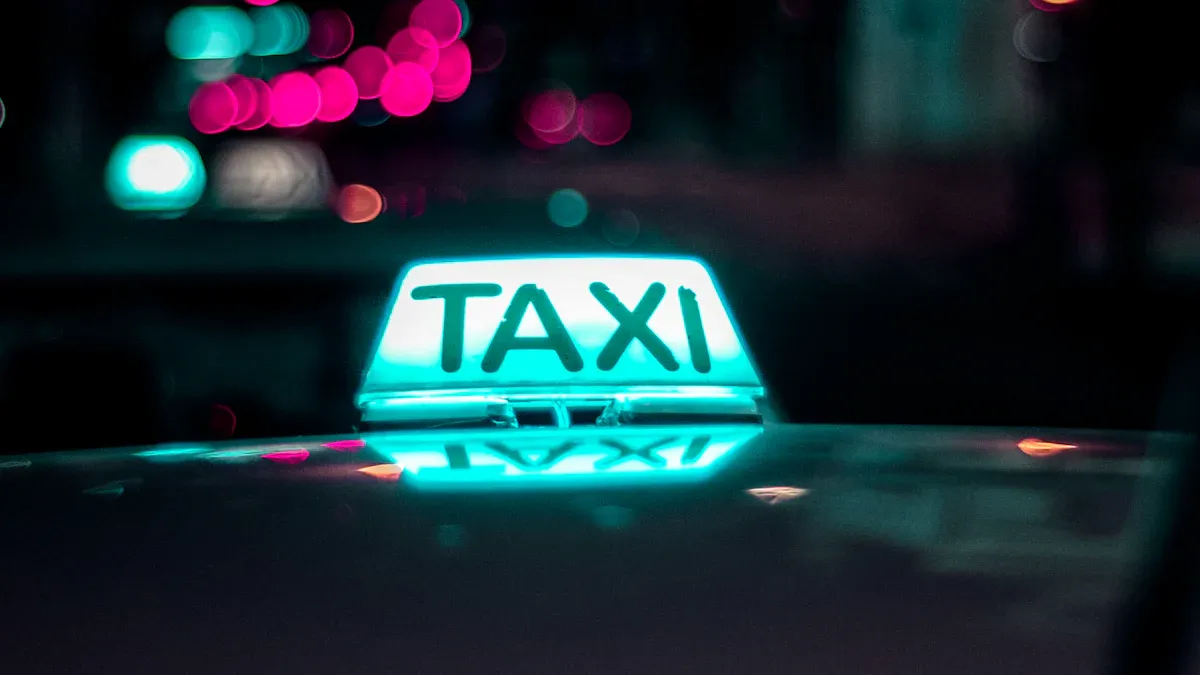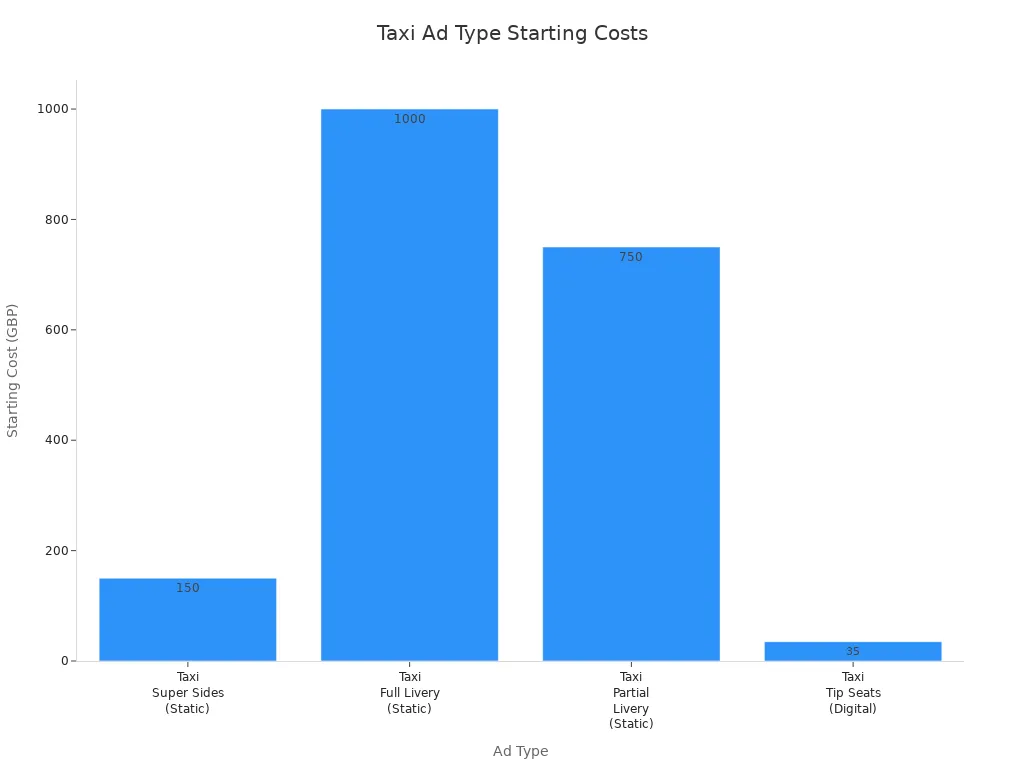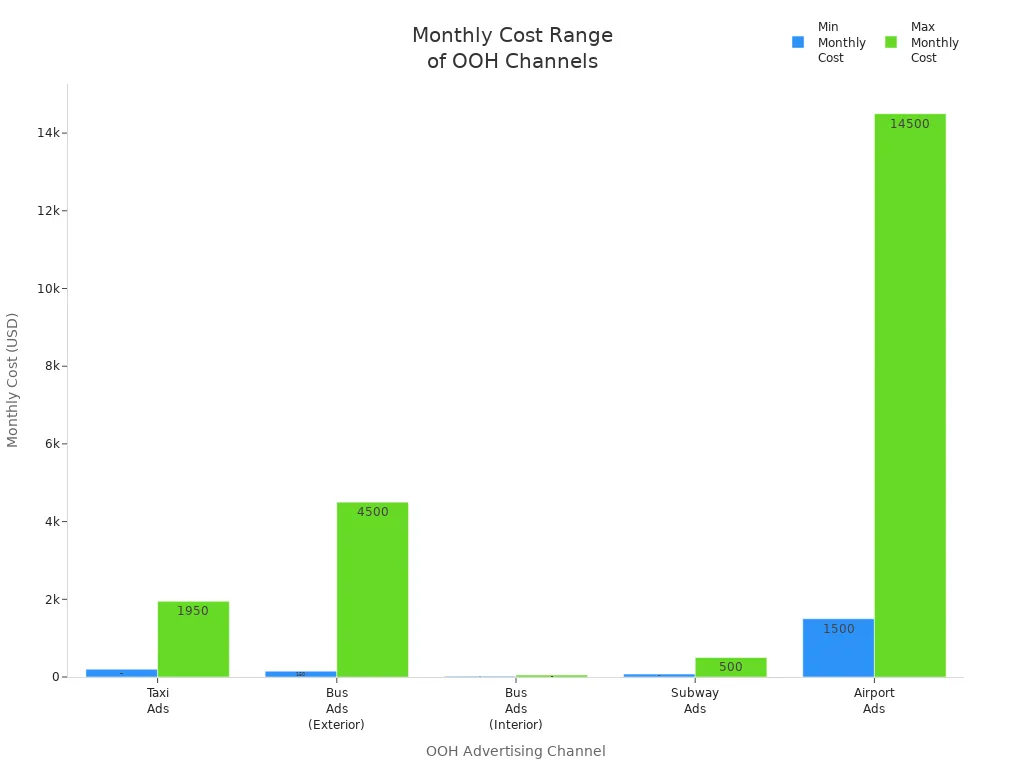
In-taxi advertising lets brands reach people riding in a cab. It uses digital screens or printed displays inside the car. This type of out-of-home advertising targets you as a passenger. Brands can show messages when you are not busy. Taxi advertising is special because it is easy to see and gets attention. It works in both cities and neighborhoods. Studies show in-taxi advertising is growing around the world. It is especially popular in big cities.
Aspect | In-Taxi Advertising | Other OOH Formats |
|---|---|---|
High, eye-level, memorable | Less personalized | |
Audience Reach | Urban, residential, mobile routes | Fixed, less flexible |
Key Takeaways
In-taxi advertising puts ads inside taxis. These ads use digital screens or posters. They reach people while they ride in the taxi. Digital and interactive ads can change fast. They can show different ads based on where the taxi is. They can also change by the time of day. This makes the ads more interesting and useful. Taxi ads reach people who cannot leave. Passengers spend time inside the cab. This helps brands get more attention. People remember these ads better than many others. This advertising does not cost a lot. Brands can reach city travelers without spending too much. Good taxi ad campaigns use clear messages. They put ads in smart places. They also check how well the ads work. This helps them get better and keep passengers interested.
In-Taxi Advertising Overview

What Is In-Taxi Advertising
You see in-taxi advertising when you ride in a taxi. These ads show up inside the car during your trip. Taxis act like moving billboards for brands. You might spot bright pictures, digital screens, or even things you can touch, like QR codes. Sometimes, there are special features like augmented reality. Ads can be on the inside panels, headrests, or even outside the taxi. Most ads inside focus on people sitting in the back seat. This makes it hard to miss the message.
Taxi advertising is different because it reaches people who cannot leave. You often have free time to look at the ads while riding. Brands use this time to share messages or talk about products. Sometimes, they offer special deals. Taxis move through busy streets and reach many kinds of people. You see these ads in cities, at airports, and during big events. There are different types, like digital screens, printed posters, and interactive displays.
Tip: You can scan a QR code or tap a screen to learn more or get a discount while you ride in a taxi.
Seeing the same ad in many taxis helps you remember it. This is called consistency and repetition. It works well for companies that want people to know their brand in cities.
How It Works
Taxi advertising uses technology to show and change ads fast. Most taxis now have digital screens inside. These screens play videos, show pictures, or let you interact. Advertisers use special software to control what you see. They can change ads right away, so you always see new messages.
Some ads match where you are or what time it is. This happens because the system uses location and real-time data. For example, you might see a coffee shop ad in the morning. Or you might see a concert ad near a music place. Advertisers use data to see which ads work best. They change their ads to get better results.
Here are some common technologies used in taxi advertising:
LCD touchscreens inside the taxi
Rooftop LED displays for outside ads
Cloud-based platforms to manage ads
Programmatic tools for buying and placing ads
Geotargeting and real-time updates using GPS
Advertisers can change the ads from far away. They use GPS and the internet to update ads quickly. If the weather changes or a big event starts, you might see new ads right away. This helps brands stay interesting and get your attention.
Inside the taxi, sensors count how many people see the ads. This helps advertisers know if their ads work. You get more fun and useful ads, and brands get better results for their money.
Note: Good network connections are needed for ads to work well. Taxi companies use strong systems so you always see the newest ads.
Taxi advertising works best with clear and simple messages. Good design and smart placement help ads stand out. By using different technology and data, advertisers make sure you see the right ad at the right time.
Types of Taxi Advertising
There are many ways to do taxi advertising. Each way has its own good points. Some work better for certain goals. Let’s look at the main types you can find today.
Digital Taxi Advertising
Digital taxi advertising uses screens inside the cab. These screens show videos, pictures, and things you can touch. The ads can change right away. You might see a coffee shop ad in the morning. At night, you could see a concert ad. Digital taxi ads stand out because they use bright colors and moving pictures. This makes you pay attention and remember the brand. Many companies pick this type for quick sales or to try new ads fast. Digital taxi ads can also show ads based on where you are.
Metric | Static Ads | Digital Ads | Taxi Top Ads (Digital) |
|---|---|---|---|
Content Flexibility | Fixed image | Dynamic, updates | Rotating, geo-targeted |
Engagement | Continuous | High | High |
Recall Rates | Risk of fatigue | Higher | Enhanced |
Mobility | Fixed | Fixed | Mobile |
Cost Range | $5k–$15k/month | $15k–$50k/month | $3k–$10k/month |
Best Use Case | Branding | Flash sales | Event targeting |
Static Taxi Cab Ads
Static taxi cab ads use printed posters or wraps. You see these on the outside or inside of the cab. Some types are trunk ads, full wraps, and rear window ads. These ads do not change during the campaign. They are good for long-term branding and cost less than digital ads. Static taxi ads give your brand steady attention, but you cannot update them fast. You may see these ads on the trunk, sides, or tip seats inside the cab.

Interactive and Geo-Targeted Ads
Interactive and geo-targeted ads make taxi ads more fun. You can scan a QR code, tap a screen, or play a game. These ads use GPS to show messages based on where you are. For example, you might get a coupon for a store nearby. Or you could see an ad for an event close to you. Interactive ads help you connect with the brand and often get more people to buy. Geo-targeted ads focus on busy places like airports or city centers. This makes the ads matter more to you.
Tip: Interactive ads can take you to an app or booking page. This makes it easy to do something right from your cab seat.
Comparing In-Taxi and Exterior Taxi Advertising
Aspect | In-Taxi Advertising | Exterior Taxi Advertising (Wraps, Rooftop Signs) |
|---|---|---|
Location | Inside the taxi, targeting passengers | Outside the taxi, visible to pedestrians and other drivers |
Audience Engagement | Direct, interactive, digital screens | Broad exposure, no direct interaction |
Visibility | Limited to passengers | High visibility on streets |
Creative Options | Rotating ads, interactive content | Bold wraps, illuminated rooftop signs |
Cost | Least expensive (~$30 per cab) | Wraps most expensive (~$2,000 per cab); rooftop ads moderate cost |
Content Dynamism | Dynamic, interactive | Mostly static; rooftop signs can rotate ads |
In-taxi ads are made for people riding in the cab. Exterior ads are for people outside the cab. Both types have special benefits. You can pick the one that fits your goal best.
Benefits of In-Taxi Advertising

Captive Audience
When you ride in a cab, you are part of a special group. Taxi interior advertising uses screens and displays you see the whole ride. You usually spend 15 to 20 minutes inside. This gives brands lots of time to show their message. You cannot leave or get distracted by things outside. Seeing the ads again and again helps you remember them. Studies say creative and colorful ads in taxis grab your attention. You remember these ads more. The cab makes you a captive audience, which is not common with other ads.
Passengers in taxis see ads for a longer time than people who see billboards or bus ads for just a few seconds.
Research shows:
Creative pictures in taxi ads get more attention than plain words.
Digital screens in cabs keep you interested during your ride.
The captive setting helps you remember brands and like the ads.
Urban Reach
You see taxis in busy city streets, airports, and neighborhoods. Taxi ads reach people in cities where other ads can get lost. Backseat screens are in over 15,000 cabs in big cities. This helps brands connect with you wherever you go. Digital taxi top ads stand out in cities. They catch your eye with bright, moving pictures. Urban reach lets brands target certain groups and places. This makes the ads matter more to you.
Cost-Effectiveness
Taxi ads cost less than many other out-of-home ads. The cost per thousand views (CPM) is about $5. This is cheaper than many digital ads. You get good results without spending a lot. Here is a quick look at how taxi ads compare to others:
OOH Advertising Channel | Monthly Cost Range (USD) |
|---|---|
Taxi Ads | $200 – $1,950 |
Bus Ads (Exterior) | $150 – $4,500 |
Bus Ads (Interior) | $20 – $50 |
Subway Ads | $75 – $500 |
Airport Ads | $1,500 – $14,500 |

You can reach lots of city people for less money. This makes taxi ads a smart pick for many brands.
Brand Impact
Taxi interior ads help brands make a strong mark. Moving and interactive screens inside the cab grab your attention. You see the same ad many times during your ride. This helps you remember the brand and want to buy. Brands use taxi ads to reach city people and build trust. Seeing the ads often as cabs move helps you remember the brand. You feel more familiar with it. Advertisers can check if their ads work by tracking if you remember and recognize them.
Main benefits:
Moving ads make you want to buy more.
Targeted ads reach the right people in the right places.
Seeing ads often helps you know and trust the brand.
Taxi Advertising Campaigns
Planning and Creative
You start a successful taxi advertising campaign by knowing your audience. Think about age, interests, and where people live or work. This helps you create ads that speak to them. Next, pick the best format for your message. You can use digital screens inside the cab, taxi top displays, or even printed ads. Make your message clear and easy to understand. Use bright colors and big fonts so riders notice your ad. Add a strong call-to-action, like a QR code or a special offer. Creative ideas, such as full-body wraps or interactive games, can make your advertising stand out. You can also use seasonal themes or local events to keep your ads fresh and relevant.
Tip: Combine your taxi advertising with social media or email campaigns for a bigger impact.
Placement and Scheduling
You want your ads to reach as many people as possible. Place your ads in cabs that drive through busy city areas, airports, and event locations. Schedule your advertising during peak hours, like morning and evening commutes, or when big events happen. Use data to match your ads with the right neighborhoods and times. For example, show fitness ads near gyms or entertainment ads near theaters. This way, your taxi advertising connects with the right audience at the right time.
Tracking and ROI
You need to know if your advertising works. Track how many people see your ad using GPS and impressions per mile. Use QR codes or special links to measure how many riders interact with your ad. Collect feedback from passengers to see if they remember your brand. Check if more people visit your website or store after the campaign. Use these numbers to calculate your return on investment (ROI). This helps you see which ads work best and where to improve.
Metric | What It Shows |
|---|---|
How many people saw the ad | |
Engagement | QR scans, clicks, feedback |
Reach | Total audience exposed |
ROI | Gains vs. costs |
Common Challenges
You may face some problems with taxi advertising. Riders can get tired of seeing the same ad, which is called ad fatigue. To fix this, change your ads often and use new designs or messages. Test different ads to see which ones people like most. Sometimes, it is hard to measure how well your ads work. Use tools like GPS tracking, surveys, and digital reports to get better data. Personalize your ads for different groups to keep them interesting. Rotate your ads every week or two to keep your campaign fresh and effective.
Note: Keeping your taxi advertising creative and updated helps you get better results and keeps riders engaged.
In-taxi advertising gives you a powerful way to reach city travelers. You can use digital screens, static posters, or interactive ads to engage a captive audience. This channel stands out for its real-time updates, location targeting, and high engagement, especially in premium taxis.
Smart taxis and ride-hailing apps help you target the right people.
New trends like AR, AI, and mobile app integration make ads more personal and fun.
You can boost your brand by following these steps:
Choose the best ad format for your audience.
Track results and improve your campaign.
In-taxi ads keep growing as cities get smarter. Start planning your campaign to connect with urban riders today.
FAQ
What types of ads can you see inside a taxi?
You can see digital videos, static posters, QR codes, and interactive screens. Some taxis show ads based on your location or the time of day. You might also find special offers or games.
How do advertisers know if their taxi ads work?
Advertisers track results using GPS, QR code scans, and feedback from riders. They check how many people see or interact with the ads. This helps them improve future campaigns.
Are in-taxi ads distracting for passengers?
Most in-taxi ads use short videos or images. These ads play on screens you can easily see. You can choose to watch or ignore them. Many riders find them helpful or entertaining.
Can you interact with in-taxi ads?
Yes! You can scan QR codes, tap screens, or play games. Some ads let you get discounts or learn more about a product right from your seat.
See Also
Understanding CarPlay Dongles And Their Benefits For Drivers
Best CarPlay Adapters Available For VW Golf In 2025
The Way Wireless CarPlay Adapters Enhance Your Driving Experience
Comparing Tesla-Inspired CarPlay Screens For Audi: Features And Costs
A Guide For Audi Owners Selecting The Right Android Auto Adapter
